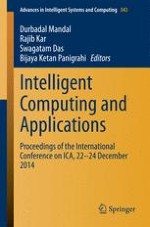The idea of the 1st International Conference on Intelligent Computing and Applications (ICICA 2014) is to bring the Research Engineers, Scientists, Industrialists, Scholars and Students together from in and around the globe to present the on-going research activities and hence to encourage research interactions between universities and industries. The conference provides opportunities for the delegates to exchange new ideas, applications and experiences, to establish research relations and to find global partners for future collaboration. The proceedings covers latest progresses in the cutting-edge research on various research areas of Image, Language Processing, Computer Vision and Pattern Recognition, Machine Learning, Data Mining and Computational Life Sciences, Management of Data including Big Data and Analytics, Distributed and Mobile Systems including Grid and Cloud infrastructure, Information Security and Privacy, VLSI, Electronic Circuits, Power Systems, Antenna, Computational fluid dynamics & Heat transfer, Intelligent Manufacturing, Signal Processing, Intelligent Computing, Soft Computing, Bio-informatics, Bio Computing, Web Security, Privacy and E-Commerce, E-governance, Service Orient Architecture, Data Engineering, Open Systems, Optimization, Communications, Smart wireless and sensor Networks, Smart Antennae, Networking and Information security, Machine Learning, Mobile Computing and Applications, Industrial Automation and MES, Cloud Computing, Green IT, IT for Rural Engineering, Business Computing, Business Intelligence, ICT for Education for solving hard problems, and finally to create awareness about these domains to a wider audience of practitioners.
